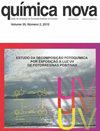基于机器学习的虚拟筛选,分子对接,药物相似,药代动力学和毒性分析,以确定新的天然抑制SARS-CoV-2糖蛋白刺突(S1)
IF 0.5
4区 化学
Q4 CHEMISTRY, MULTIDISCIPLINARY
引用次数: 0
摘要
鉴定天然生物活性化合物(NBCs)作为潜在的抑制剂尖刺(S1)的手段在硅分析。通过虚拟筛选和分子对接,从ZINC数据库中获得先前已证实具有体外生物学活性的NBCs,并对其进行分析,以鉴定出与刺突蛋白亲和力较高的NBCs。采用主成分分析(PCA)、人工神经网络(ANN)、支持向量机(SVM)、k近邻(KNN)、偏最小二乘判别分析(PLS-DA)、梯度提升树判别分析(XGBoostDA)、类类比的软独立建模(SIMCA)和逻辑回归判别分析(LREG)等8种机器学习模型对结果进行验证。选定的nbc节目使用利平斯基和韦伯的五法则进行药物相似性预测。还进行了药代动力学参数和毒性预测(ADMET)。目前用于COVID-19的抗病毒药物(remdesivir和molnupiravir)被用作比较物。共分析了170,906种化合物。其中34个与S1具有较强的亲和力(亲和能< -7 kcal mol-1)。这些化合物大多属于香豆素类(苯并吡咯酮类),呈现一个苯环与内酯(杂苷群)融合。PLS-DA模型能够再现虚拟筛选和分子对接的结果(准确率为97.0%)。在34种化合物中,只有NBC5(费塞尔罗)、NBC14、NBC15和NBC27在ADMET预测中有更好的结果。与remdesivir和molnupirvir相比,这些与S1具有相似的结合亲和力。非塞罗和其他三种nbc是治疗COVID-19最有希望的候选药物。需要进行体内和体外研究来证实这些发现。本文章由计算机程序翻译,如有差异,请以英文原文为准。
MACHINE LEARNING-BASED VIRTUAL SCREENING, MOLECULAR DOCKING, DRUG-LIKENESS, PHARMACOKINETICS AND TOXICITY ANALYSES TO IDENTIFY NEW NATURAL INHIBITORS OF THE GLYCOPROTEIN SPIKE (S1) OF SARS-CoV-2
To identify natural bioactive compounds (NBCs) as potential inhibitors of spike (S1) by means of in silico assays. NBCs with previously proven biological in vitro activity were obtained from the ZINC database and analyzed through virtual screening and molecular docking to identify those with higher affinity to the spike protein. Eight machine learning models were used to validate the results: Principal Component Analysis (PCA), Artificial Neural Network (ANN), Support Vector Machine (SVM), k-Nearest Neighbors (KNN), Partial Least Squares-Discriminant Analysis (PLS-DA), Gradient Boosted Tree Discriminant Analysis (XGBoostDA), Soft Independent Modelling of Class Analogies (SIMCA) and Logistic Regression Discriminate Analysis (LREG). Selected NBCs were submitted to drug-likeness prediction using Lipinski’s and Veber’s rule of five. A prediction of pharmacokinetic parameters and toxicity was also performed (ADMET). Antivirals currently used for COVID-19 (remdesivir and molnupiravir) were used as a comparator. A total of 170,906 compounds were analyzed. Of these, 34 showed greater affinity with the S1 (affinity energy < -7 kcal mol-1). Most of these compounds belonged to the class of coumarins (benzopyrones), presenting a benzene ring fused to a lactone (group of heterosides). The PLS-DA model was able to reproduce the results of the virtual screening and molecular docking (accuracy of 97.0%). Of the 34 compounds, only NBC5 (feselol), NBC14, NBC15 and NBC27 had better results in ADMET predictions. These had similar binding affinity to S1 when compared to remdesivir and molnupirvir. Feselol and three other NBCs were the most promising candidates for treating COVID-19. In vitro and in vivo studies are needed to confirm these findings.
求助全文
通过发布文献求助,成功后即可免费获取论文全文。
去求助
来源期刊

Quimica Nova
化学-化学综合
CiteScore
1.60
自引率
12.50%
发文量
72
审稿时长
2-4 weeks
期刊介绍:
Química Nova publishes in portuguese, spanish and english, original research articles, revisions, technical notes and articles about education in chemistry. All the manuscripts submitted to QN are evaluated by, at least, two reviewers (from Brazil and abroad) of recognized expertise in the field of chemistry involved in the manuscript. The Editorial Council can be eventually asked to review manuscripts. Editors are responsible for the final edition of QN.
 求助内容:
求助内容: 应助结果提醒方式:
应助结果提醒方式:


